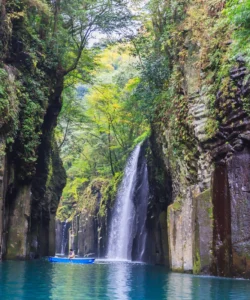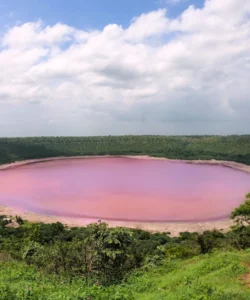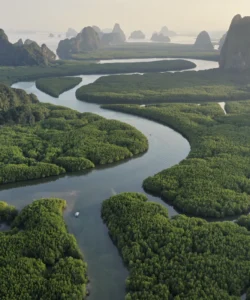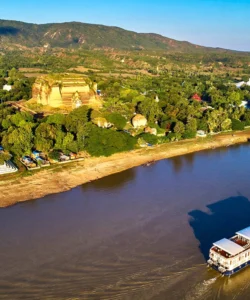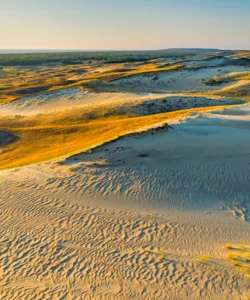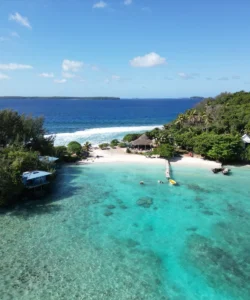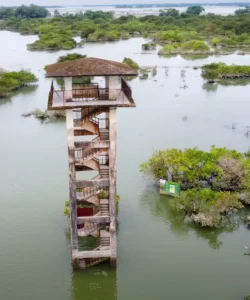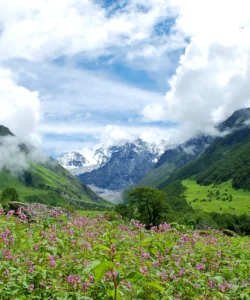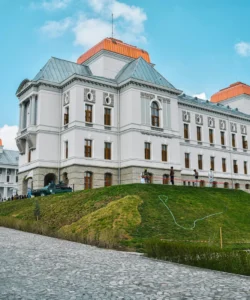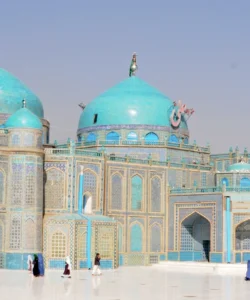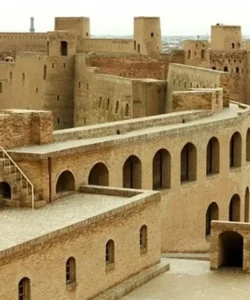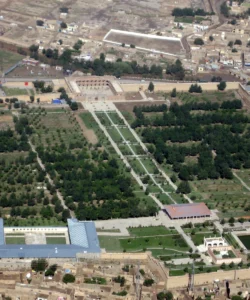Al Ahsa Oasis, located in the Eastern Province of Saudi Arabia, is a spectacular and historic natural wonder. It is renowned as the world’s largest and most extensive self-contained oasis, a verdant sea of more than 2.5 million date palms that has sustained continuous human settlement for millennia. This living cultural landscape is a testament to the enduring relationship between people and nature in an arid environment.
Name: Al Ahsa Oasis (Arabic: الْأَحْسَاء, al-Aḥsāʾ)
Address: The oasis is located in the Al Ahsa Governorate, Eastern Province, Saudi Arabia. The primary city and cultural hub of the oasis is Hofuf.
How to Get There:
Al Ahsa Oasis is a major destination in Saudi Arabia, and its access is convenient through various transport links.
- By Air: The closest airport is Al Ahsa International Airport (HOF). It has regular domestic flights from major Saudi cities like Riyadh and Jeddah. From the airport, a taxi or pre-arranged transfer can take you to the main tourist areas in and around Hofuf (a short drive of about 20 minutes).
- By Train: This is a popular and comfortable option. The Saudi Arabia Railways (SAR) operates trains that connect Hofuf to Riyadh (approx. 2.5 hours) and Dammam (approx. 1.5 hours). The train journey offers a scenic view of the desert landscape.
- By Road: Al Ahsa is well-connected by road to other major cities. The drive from Riyadh takes about 3-4 hours, and from Dammam, it’s about 1.5 hours. You can hire a private car or use ride-sharing services (e.g., Uber, Careem).
- Exploring the Oasis: The oasis itself is vast. Visitors can drive through its sprawling palm groves, explore the old towns and archaeological sites, and visit its mountains and lakes. It is a good idea to have a car or hire a local driver to explore the various components of this cultural landscape.
- Best Time to Visit: The cooler, dry season, from October to April, is the ideal time to visit. Summers in Al Ahsa can be extremely hot.
Landscape and Architecture:
Al Ahsa Oasis is a unique geocultural landscape, where its natural features are inseparably linked to centuries of human ingenuity and traditional architecture.
- World’s Largest Palm Oasis: The defining feature of the oasis is its immense scale, with over 2.5 million date palm trees covering an area of over 8,500 hectares. This creates a mesmerizing and lush green landscape that is a stark contrast to the surrounding desert (the Rub’ al Khali to the south and the Ad-Dahna sand belt to the west).
- Underground Aquifer and Springs: The oasis is sustained by an enormous underground aquifer, which is fed by more than 280 artesian springs and wells. These natural water sources allowed for continuous cultivation and human settlement for millennia. An intricate system of open-air canals and irrigation channels, developed over centuries, distributes this water throughout the palm groves, demonstrating remarkable hydraulic engineering.
- Al Qarah Mountain (Jabal Al-Qarah): A significant natural landmark within the oasis. This limestone mountain features unique caves and canyons that have been naturally carved by sub-aerial weathering (e.g., from rain and rivers). The caves have a unique, cool microclimate, offering a refreshing escape from the desert heat.
- Al Asfar Lake (Yellow Lake): A beautiful drainage lake in the eastern part of the oasis, surrounded by sand dunes and a marshland environment that is a haven for migratory birds. It’s a popular spot for photography and birdwatching.
- Traditional Urban Fabric and Architecture: The oasis is home to a rich historical and architectural heritage, particularly in the city of Hofuf.
- Ibrahim Palace: A noteworthy example of Ottoman-era architecture, this historic fort in Hofuf blends Islamic and military styles, with towering walls, arched windows, and a grand mosque with domes and minarets. It was built using local materials like mud mixed with straw, palm trunks for ceilings, and stone floors.
- Suq Al-Qaisariyah: One of the oldest traditional markets in the region, featuring a unique covered architecture with a series of buildings arranged in a cross-axis, creating a vibrant commercial hub.
- Jawatha Mosque: This mosque, with remnants of its original structure, is believed to be the earliest mosque built outside of Medina, dating back to the 7th century, making it a site of immense religious significance.
- Traditional Fortresses and Houses: The oasis is dotted with ancient forts, mosques, and traditional houses (often in ruins) that showcase the evolution of local architectural styles from the early Islamic period to the present day.
What Makes It Famous:
- World’s Largest Oasis: Al Ahsa Oasis is globally recognized as the largest self-contained palm oasis in the world, a truly massive and vibrant testament to the power of nature and human effort in a desert environment. It is home to over 2.5 million date palms.
- UNESCO World Heritage Site: Inscribed in 2018, it is recognized as an “evolving cultural landscape” for its outstanding universal value. The site’s heritage (gardens, canals, springs, archaeological sites, historic towns, and forts) exemplifies the interaction between human settlement and the natural environment in the Arabian Peninsula since the Neolithic period.
- Ancient Trade and Pilgrimage Hub: For millennia, Al Ahsa was a vital crossroads for trade and cultural exchange, a major source of dates, and a crucial resting place for early pilgrims on their journey to Mecca.
- Unique Geological Formations (Al Qarah Mountain): The presence of Al Qarah Mountain, with its surreal natural caves and canyons, adds a distinct geological wonder to the oasis landscape.
- Oldest Mosque outside Medina: The historical Jawatha Mosque, with its 7th-century origins, is a significant religious landmark for Muslims.
- Rich Agricultural Heritage: The oasis is a key agricultural hub in Saudi Arabia, famous for producing over 100,000 tons of dates annually, and preserving traditional farming techniques.
- Vibrant Culture and Handicrafts: The region is renowned for its traditional crafts, such as weaving, pottery, and the burning of oud (a sacred ritual of hospitality), showcasing a rich and continuous cultural heritage.
Differences from Some Other Wonders:
- Scale of Oasis: While other oases exist, Al Ahsa’s fame is singularly tied to its unrivaled size and its status as the world’s largest. This monumental scale is its primary physical distinction.
- “Evolving Cultural Landscape” UNESCO Designation: Unlike sites that are either purely natural (e.g., Edge of the World) or ancient archaeological cities (e.g., Hegra, AlUla Old Town), Al Ahsa’s UNESCO status specifically recognizes it as an “evolving cultural landscape,” meaning it is a living, working environment where a 5,000-year-old tradition of human-nature interaction and irrigation continues to this day.
- Mix of Natural and Historical Sites: The oasis is not a single point of interest. Its “wonder” is a composite of diverse elements, including the lush palm groves, natural springs, a lake, unique mountains, and a collection of historical forts, mosques, and markets.
- Sophisticated Hydraulic Engineering: The enduring “qanats” (underground water channels) and irrigation systems, some dating back millennia and still in use, highlight a specific mastery of hydraulic engineering in an arid climate that is central to the oasis’s existence and fame.
- Jawatha Mosque’s Significance: While other Saudi sites like Hegra and AlUla have historical connections to Islamic scripture, Al Ahsa’s Jawatha Mosque holds a unique and direct religious significance as the first mosque believed to be built outside of Medina and the location of the second Friday prayer in Islam, giving it a specific spiritual place in early Islamic history.
- Absence of Monumental Rock-Cut Tombs: Unlike Hegra, which is a necropolis of grand rock-cut tombs, Al Ahsa’s architectural heritage is predominantly in built structures, fortifications, and traditional urban fabric.
- Focus on Sustained Agriculture: Its core purpose and fame are tied to its continuous agricultural production, particularly dates, rather than just being a historical trade or pilgrimage stop. This economic and agricultural function is a living part of the wonder.
Al Ahsa Oasis Photos:

























